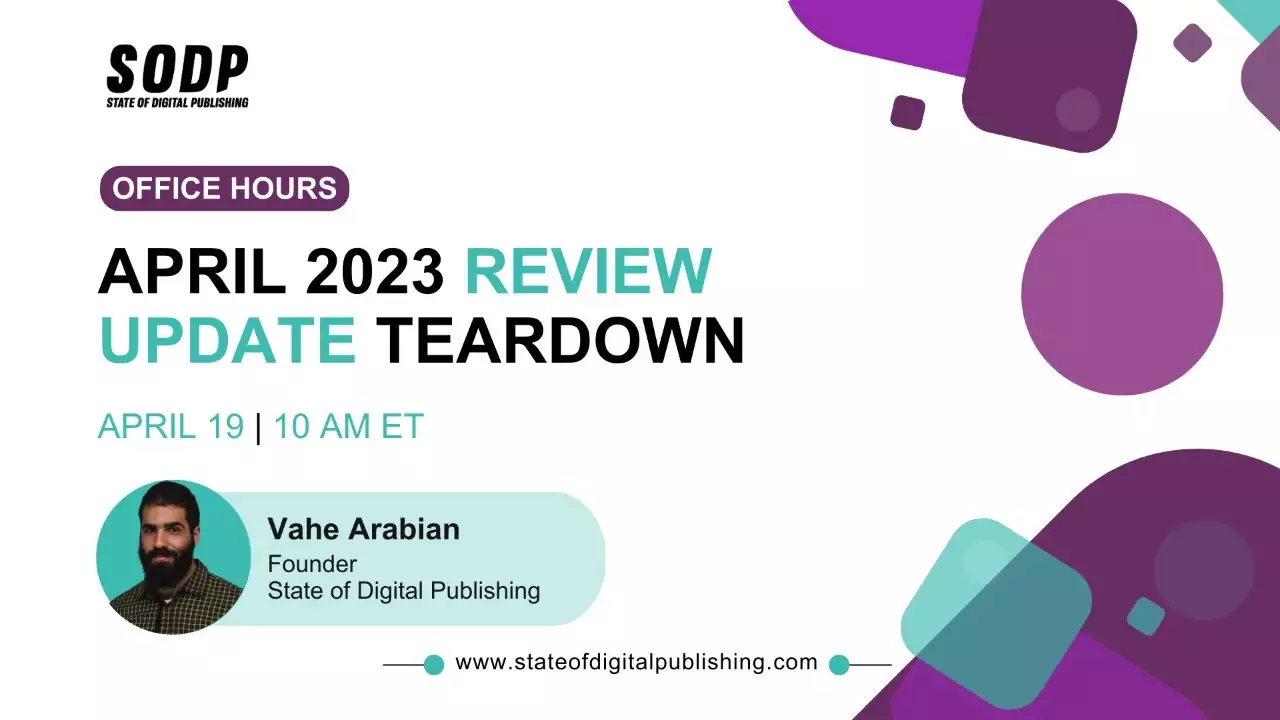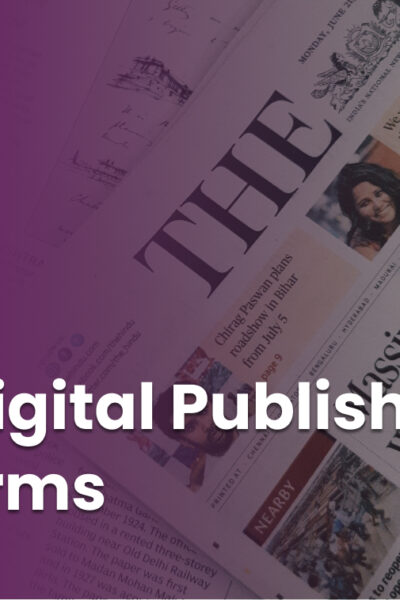Between inflationary pressures and recession fears, digital publishers more than ever need to identify industry trends that can improve their business outcomes and reader relationships.
There are three overarching themes that dominate the current trends among digital publishers — technological, business and audience development.
Digital publications are embracing AI to boost performance and efficiency, while also considering the ways in which it can impact the editorial side of the business. Increased efficiency is critical in the industry, with rising costs placing added importance to that old adage “doing more with less”.
On the business side, media companies are also looking for efficiency gains as they strive to reach new audiences and multiply revenue streams.
Justin Hansen, COO and co-founder of media advisory and analytics service Media Tradecraft, told State of Digital Publishing (SODP): “Publishers will focus more on content data, including bridging editorial with revenue analytics to help drive effective decisions and profitability.”
So, let’s look more closely at several important digital publishing trends of 2023 and the impact they’re having on the industry.
Technological Revolution
The digital publisher-technology relationship is changing, with both AI and mobile optimization the focus for the industry this year.
AI has garnered an unprecedented level of interest in the opening months of 2023, creating a polarizing divide in the process. Yet despite the concerns of some, several larger publishers have begun experimenting with the tech.
Meanwhile, the ongoing shift from desktop to mobile internet usage, means mobile optimization is continuing to play a key role in user experience (UX) design. Readers now expect to be able to access content seamlessly across devices, with the continuing rollout of 5G internet worldwide underpinning that expectation.
1. AI

Sam Altman, CEO of OpenAI
Source: Flickr
The rise of large language models (LLMs) has stoked fears that AI will replace writers. While that may be the case with AI generated content in the future, we’re not there yet and problems with the tech suggest creatives shouldn’t worry too much just yet.
While brands such as KitKat are normalizing the relationship between AI and saving time, the task for publishers is more complex and carries serious risk if applied without great care.
AI may be able to generate content, but this is not how the publishing industry will benefit the most in 2023.
The technology can help publishers better understand their audiences and improve brand discoverability. Indeed, AI has been playing a major role in providing advanced insight into user preferences and behavior for some years and this will continue. Indeed, the machine learning market’s value is forecast to grow from $19 billion in 2022 to almost $226 billion in 2030.
Publishers can use this marketing technology to improve reader engagement, increase the time they spend on site and improve the likelihood of them turning into subscribers.
Digital publishers and advertisers have relied on third-party cookies to help build audience profiles, but this will become harder once Google finally deprecates cookies. Without third-party cookie data digital publishers and marketers will have to rely solely on first-party data. With this data, publishers and ad tech partners are able to build audience profiles more easily for contextual advertising and to improve reader engagement.
Bal Heroor, the CEO of Mactores, explained to SODP: “The publishing industry faces several data analytics challenges that must be addressed to optimize processes, enhance customer engagement and improve overall business performance.”
Heroor added: “By leveraging advanced analytics techniques and embracing digital innovation, publishers can overcome these obstacles and continue to thrive in an increasingly competitive landscape.”
2. Mobile Optimization

Number of mobile internet users worldwide from 2019 to 2028
Source: Statista
It’s no secret that internet traffic on mobile phones has significantly increased and continues to do so. The image above shows the number of users is expected to grow from 5.2 billion this year to 6.1 billion in 2028.
The share of traffic from mobile devices has soared from 10.88% in 2012 to almost 60% in 2022. This shift has made the embracing of responsive design for content and ads more important than ever.
Mobile optimization will mean different things to different industries, but for digital publishers the focus should be on these three aspects:
- Streamlining: Deliver the same content across both mobile and desktop, but keep the layout and design simple to cater to the mobile UX.
- Advertising: Avoid intrusive interstitials and consider native and banner ads instead.
- Subscriptions: As with online shopping, publishers need to consider how easy it is for visitors to subscribe. A one-click solution is the answer.
The added benefit of optimizing for mobile is the fact this is one of the central themes of optimizing content for search engines, thereby helping with audience discovery.
Business Development

Rather than trying to predict the future, more publishers are looking to build an organization that can handle unpredictability. This approach relies on building the two key assets.
The first is tech stacks, which involves investing in simple but more flexible integrated technology. The second key is people — recruiting and keeping a great team is essential to future overcoming obstacles and growing new revenue streams.
3. Diversifying Revenue

Subscriptions will remain a focus this year, with one survey showing that 80% of publishers believe subscriptions will be a top revenue priority. This is because 68% expected revenue from subscriptions/paid content to increase this year.
That being said, the weaker economic outlook has made it imperative for publishers to diversify their revenue streams. The publishing industry has been experimenting with alternative revenue models for several years, with the New York Times’ acquisition of consumer guide Wirecutter in 2016 one of the more high-profile examples of this mindset. Other examples include the launch of CNN Coupons in 2018.
Hector Pantazopolous, co-founder and CRO of SourceKnowledge, told SODP: “To navigate these times, publishers may need to turn to additional streams of monetization, including exploring a more varied vendor pool, an openness to working with different [ad revenue] models … and selling additional content types (sponsorship posts).”
Pantazopolous added that economic pressures would drive “demand for deals and coupons”, which publishers were well placed to serve. He said: “Reputable news platforms promoting product-related content and deals, such as Business Insider Reviews or CNN Coupons, are expanding the horizons of digital publishing, and we expect to see more examples of this across publications in the coming years.”
He said: “Publishers will continue creating authentic and relevant content with the goal of selling products and facilitating the checkout process. Content pieces (such as reviews, comparisons, guides, and listicles) and saving incentives (such as discounts and codes) help justify purchase decisions.”
4. Brand Publishing

Brand publishing is far from a new model, but is set to grow in importance as brands seek to raise awareness and acquire new audiences.
The start of the year saw Robinhood announce the formation of Sherwood Media, with the goal of publishing content on markets, economics, business and technology.
Positioned as a subject matter expert, brands are able to influence industry narratives and increase perceptions of their reliability and trustworthiness. Looking at brand publishing through an economics lens, the segment benefits from its cost efficiency.
Indeed, it seems that many brand publishing divisions are actively looking to prove their worth during the economic slowdown. That’s not to say there won’t be challenges ahead, however, with those in space both worrying about competition from AI as well as wondering how to leverage the tech to boost efficiencies.
Content from our partners
Audience Development
Building a loyal audience requires more than simply offering great content — it’s also about positive experiences. Publishers engaging with the experience economy have a better chance of engaging with their audience in an inherently personal way.
5. Personalisation
It’s already well established that personalisation and interactivity, which focuses on meeting individual customer needs, increases customer engagement. Personalisation is about knowing the audience, and understanding their preferences to deliver content they want, when they want it.
We’ve already talked about how publishers are leaning on AI to understand more about their audiences to serve content that best matches their interests. That’s the passive approach, and is just one half of the personalization options publishers have at their disposal. The other half focuses on more active steps publishers can take, such as small surveys on user interest.
There is an increased interest in customer engagement over the last decade. Research has shown that 71% of consumers expected personalized interactions from companies and 76% get frustrated when this isn’t offered.
6. Videos

We’ve seen audiences become increasingly invested in video content in recent years, and this is driving publishers to offer alternative options.
The news publishing sector is ramping up its investment in short-form videos, with TikTok in particular considered to offer the most growth potential and value. Social media platforms also offer digital publishers access to a younger audience who are more active and engaged.
Audiences are now using multiple devices simultaneously, meaning increased risks to their attention being hijacked. In a visually rich and competitive market, the short-form video is king, requiring less time to capture attention and connect with the audience. Audiences are more likely to share short videos, given their likelihood of the recipient immediately consuming the content.
That’s not to suggest that long-form video is dead, with even TikTok experimenting with longer runtimes in an effort to help creators develop monetization options. Long-form videos remain a great way to engage audiences over more complex topics.
Final Thoughts
Many of the above publishing trends are interconnected, with AI being the perfect example. The technology bridges many separate aspects of the publishing business, from editorial to operations and advertising.
That’s not to diminish the importance of the trends it doesn’t touch, however. Publishers need to be aware of and understand how all the trends mentioned can benefit their business. From making the most of available resources to optimizing for mobile, any and all of these trends offer tangible benefits.
The digital publishing industry is now in a position where more tools and resources are available than ever before to improve workflows and creative output.












